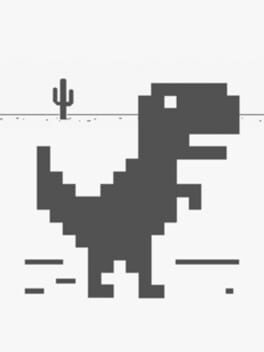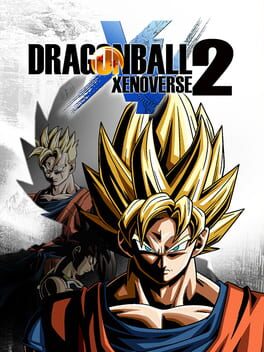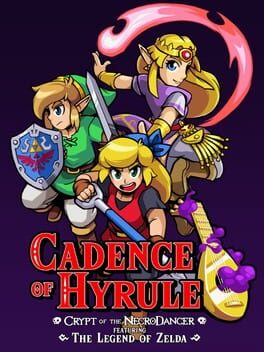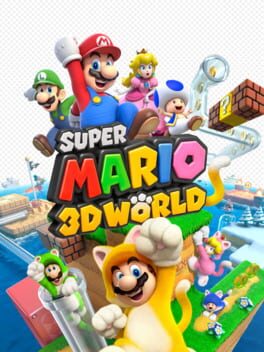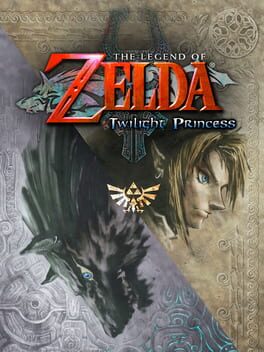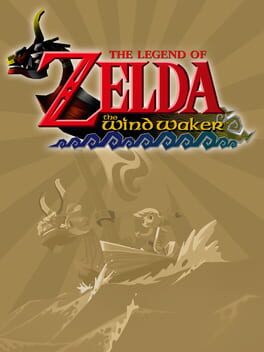Krstyl
9 reviews liked by Krstyl
Resident Evil 4
2023
NieR: Automata
2017
Chrome Dino
2014
Cadence of Hyrule has a lot to love. The gameplay is unique, the art direction is gorgeous, the remixed music is excellent, and this is one of the few games where you can play as Zelda. Not to mention this is an extraordianry case of Nintendo entrusting one of their flagship IPs to an indie developer. It’s a miracle this game even exists! But before I gush further, I must address its prominent flaw: difficulty balancing.
If you’re like me and never played Crypt of the NecroDancer before, the combat will feel alien and you’ll probably die several times before getting into the groove. I got used to it after about half an hour, but I also got a broadsword that could simultaneously attack all enemies in the horizontal row in front of me. The broadsword is perhaps too useful, as I ended up using it for almost the entirety of my playthrough. I still died here and there, but halfway through I became so powerful I didn’t have to think much to defeat groups of enemies. That really sucks since the enemy variety is actually quite decent. The bosses, however, desperately needed a health buff. Apart from the last two fights, they all died in less than a minute. Not every game should be crushingly difficult, but it’s unfortunate enemies don’t scale with you. I’ll explain why later.
Being a Zelda crossover, it would be natural to expect some puzzle-solving and exploration. Well, I’ve got good news and bad news. The bad news is block pushing puzzles are the order of the day. You’ll use them to reach high ledges and that’s it. This is extremely standard for Zelda and it doesn’t get more complex than that. I have a sneaking suspicion why that is and it’s actually tied to the good news.
Cadence of Hyrule has very engaging exploration. In a surprise strength over most Zelda games, you have a TON of freedom in tackling dungeons and acquiring items. There’s very little gatekeeping and many items are completely optional. Furthermore, the dungeons are focused around combat instead of puzzles, which actually solves an issue A Link Between Worlds had. In that game, almost every dungeon required a specific item to enter and since you could tackle dungeons out of order, every dungeon could only be built with that one item in mind, limiting the puzzle complexity. It was a necessary sacrifice for the freedom of exploration, but Cadence of Hyrule offers a better idea. Rather than a necessary key to open an elaborate lock, items mainly exist to help you out in combat. As a result, they became geunine rewards for exploring.
That is why I think enemy scaling would work very well. If stronger enemies appeared over time, item usage would be heavily encouraged. They wouldn’t be required to kill enemies, but they could help during battle and be used to uncover optional secrets. This would avoid ALBW’s pitfall while still preserving the freedom to explore. It also avoids Breath of the Wild’s method of giving you all your abilities at the start, which removed that feeling of finding cool new items throughout the game. The only downside to all of this is that puzzles would have to be very simple or confined to optional areas. Cadence of Hyrule knows this, as there are a lot of bombable walls and hookshot targets for optional goodies. The block puzzles can also be solved faster if you have items like the Power Glove and Rito’s Feather.
It certainly isn’t perfect, but Cadence of Hyrule is intriguing. It has all the ingredients for making an open-world Zelda while preserving the fun of acquiring items in the older games. I will always have a soft spot for the puzzles in past Zelda dungeons, but it’s clear that some kind of sacrifice has to be made if they are to play a prominent role. How much that affects you will depend on your preferences, so if you haven’t already, I recommend checking out Cadence of Hyrule to see for yourself. Don’t worry about the combat being gimmicky. It’s really fun and there’s even an option to make enemies move only when you do, which is perfect for those who struggle with musical rhythm.
If you’re like me and never played Crypt of the NecroDancer before, the combat will feel alien and you’ll probably die several times before getting into the groove. I got used to it after about half an hour, but I also got a broadsword that could simultaneously attack all enemies in the horizontal row in front of me. The broadsword is perhaps too useful, as I ended up using it for almost the entirety of my playthrough. I still died here and there, but halfway through I became so powerful I didn’t have to think much to defeat groups of enemies. That really sucks since the enemy variety is actually quite decent. The bosses, however, desperately needed a health buff. Apart from the last two fights, they all died in less than a minute. Not every game should be crushingly difficult, but it’s unfortunate enemies don’t scale with you. I’ll explain why later.
Being a Zelda crossover, it would be natural to expect some puzzle-solving and exploration. Well, I’ve got good news and bad news. The bad news is block pushing puzzles are the order of the day. You’ll use them to reach high ledges and that’s it. This is extremely standard for Zelda and it doesn’t get more complex than that. I have a sneaking suspicion why that is and it’s actually tied to the good news.
Cadence of Hyrule has very engaging exploration. In a surprise strength over most Zelda games, you have a TON of freedom in tackling dungeons and acquiring items. There’s very little gatekeeping and many items are completely optional. Furthermore, the dungeons are focused around combat instead of puzzles, which actually solves an issue A Link Between Worlds had. In that game, almost every dungeon required a specific item to enter and since you could tackle dungeons out of order, every dungeon could only be built with that one item in mind, limiting the puzzle complexity. It was a necessary sacrifice for the freedom of exploration, but Cadence of Hyrule offers a better idea. Rather than a necessary key to open an elaborate lock, items mainly exist to help you out in combat. As a result, they became geunine rewards for exploring.
That is why I think enemy scaling would work very well. If stronger enemies appeared over time, item usage would be heavily encouraged. They wouldn’t be required to kill enemies, but they could help during battle and be used to uncover optional secrets. This would avoid ALBW’s pitfall while still preserving the freedom to explore. It also avoids Breath of the Wild’s method of giving you all your abilities at the start, which removed that feeling of finding cool new items throughout the game. The only downside to all of this is that puzzles would have to be very simple or confined to optional areas. Cadence of Hyrule knows this, as there are a lot of bombable walls and hookshot targets for optional goodies. The block puzzles can also be solved faster if you have items like the Power Glove and Rito’s Feather.
It certainly isn’t perfect, but Cadence of Hyrule is intriguing. It has all the ingredients for making an open-world Zelda while preserving the fun of acquiring items in the older games. I will always have a soft spot for the puzzles in past Zelda dungeons, but it’s clear that some kind of sacrifice has to be made if they are to play a prominent role. How much that affects you will depend on your preferences, so if you haven’t already, I recommend checking out Cadence of Hyrule to see for yourself. Don’t worry about the combat being gimmicky. It’s really fun and there’s even an option to make enemies move only when you do, which is perfect for those who struggle with musical rhythm.
Super Mario 3D World
2021
This feels like a director’s cut of 3D Land. Slightly more interesting level design, but still boring for a Mario game. The top-down camera not only makes most levels feel samey, but also makes jumping risky due to poor depth perception. I know that was done for the multiplayer, but the levels feel like they were designed for two players at most and online play is prone to lag. The game is definitely better in single-player, but both types of play fall short, which suggests Nintendo had mixed priorities during its development. It’s still fun, but there are better Mario games to choose from.
Zelda fans seem to be in one of two camps on Twilight Princess. Some think it was a great iteration on Ocarina of Time, fixing nearly all of its flaws and adding things that weren't possible in the N64 classic. Others accuse it of playing it safe and starting the series' stagnation until Breath of the Wild's arrival. I've grappled extremely hard with both arguments over the years. You can tell from my rating that I love this game, but believe it to be flawed. I'm going to address the most significant gripes critics and fans have before getting to why I think this game is not only underrated, but one of the best Zelda games.
The biggest complaint I've seen is the two-hour tutorial. This lasts from the moment you press Start to arriving in the first dungeon. I understand this argument a lot, especially when you consider that previous Zelda games had more elegant tutorials. The key difference with Twilight Princess (and Skyward Sword) is that it has a greater focus on character development than past games. You will spend enough time with the village children that you actually feel the urge to rescue them after they are kidnapped, even the two brothers that bully Colin. Not only that, but you are transformed into a wolf against your will. Both Link and the player are unfamiliar with this new body and the surrounding Twilight, which unsettles the player as much as it intrigues. The bug hunts required to restore each section of Hyrule could have been more interesting, as evidenced by Skyward Sword's silent realms, but there is something to be said for how Twilight Princess forces you to traverse these initially unfamiliar environments in a unique way.
I've seen some people argue that Twilight Princess really doesn't get going until Midna's desperate hour. I don't agree with this because of the emotional weight threading Link's initial journey to rescue and help the village children. You rescue Colin from King Bulbllin, which is not only one of the coolest sequences in a video game, but also emotionally strong because you have a connection with Colin. This wouldn't have been nearly as effective if the game asked you to rescue him with little context. Later, you escort Ilia and the sexy bar owner Telma to Kakariko Village to save a dying Zora prince. This act, of course, allows Link to gain the Zora's trust, but it's made extra effective by how Ilia saved the Zora prince at the cost of injuries that damaged her memory, as well as the beautiful remix of Ocarina of Time's Serenade of Water when Link visits the graveyard for the Zora tunic. These moments address the reason Link set out on his adventure in the first place while slowly revealing more about the greater threat to Hyrule.
Another big issue many detractors seem to have is that Twilight Princess tries too hard to be edgy, unfavorably comparing it to Majora's Mask. The creepy cutscene in Lake Hylia definitely supports this argument. Even I think it clashed very hard with the game's overall tone, but this is basically the only instance of that happening. The game has its dark moments, but it also has plenty of light-hearted ones. If you didn't cry when the two Yetis in Snowpeak Ruins confessed their love for each other, there's definitely something wrong with you. Zelda games have always had a balance of light and dark storytelling moments. May I remind you that the cutesy Wind Waker has red-eyed zombies with paralyzing screeches?
The last notable gripe I've seen is that the game is too easy. I won't bother denying this, as it's one of the easiest Zelda games in existence. Now that I've played Dark Souls, which has a lot in common with Zelda, I can comfortably say that the combat of Twilight Princess didn't reach all of its potential. I believe it had the most interesting combat ideas in the series, but the enemies needed to be much harder and varied. I didn't mind the bosses being about spectacle, as they were still fun to fight. I especially loved the Zant fight for how each phase gradually becomes more insane, befitting of how warped and pathetic he really is. I know many didn't like that Ganondorf was in the game, but without him, Zant's character revelation would not have worked.
If you are familiar with the series and dislike Twilight Princess, this is probably the point where you will argue that most of its scenarios were attempted in some capacity in Ocarina of Time. Nobody can doubt Twilight Princess follows closely in that game's footsteps, but just how close is too close? The game's structure was unchanged, but you can see the developers made attempts to improve on the weaker elements of Ocarina. Midna is an improvement over Na'vi, horseback combat is actually fun, and minor characters in the story are given enough screen time that you actually care about them.
More than anything, Twilight Princess wants to take you on an adventure of epic proportions. Introducing cinematic elements was a logical way of accomplishing this. Was it perfect? Of course not. But even at its wobbliest, Nintendo demonstrates a level of skill that few developers have matched. It would have been so easy for the Zelda team to take advantage of the game's cinematic focus and overindulge in underdeveloped set piece gimmicks or unskippable cutscenes that take away the player's control for long stretches of time. Twilight Princess is not like that despite the aforementioned missed potential. It knows it's a game at the end of the day. The only question is whether you want to go on the journey it offers. I say you absolutely should.
At the end of the day, The Legend of Zelda: Twilight Princess is an iterative sequel. It is an oddity in a series that is always trying to surprise players. Because it was a one-off exercise, however, I do not mind that Nintendo went back to the Ocarina template. It laid the groundwork for deeper storytelling in the series and many Zelda fans would probably still be upset at the company if every game in the series was including radically different gameplay elements. Twilight Princess is a reminder to Nintendo and gamers longing for change that a straightforward sequel is okay every once in a while. As long as the power that comes with a series like Zelda is handled responsibly, whether that's with new gameplay experiments or adding onto an existing foundation, there is no reason to be worried for its future.
The biggest complaint I've seen is the two-hour tutorial. This lasts from the moment you press Start to arriving in the first dungeon. I understand this argument a lot, especially when you consider that previous Zelda games had more elegant tutorials. The key difference with Twilight Princess (and Skyward Sword) is that it has a greater focus on character development than past games. You will spend enough time with the village children that you actually feel the urge to rescue them after they are kidnapped, even the two brothers that bully Colin. Not only that, but you are transformed into a wolf against your will. Both Link and the player are unfamiliar with this new body and the surrounding Twilight, which unsettles the player as much as it intrigues. The bug hunts required to restore each section of Hyrule could have been more interesting, as evidenced by Skyward Sword's silent realms, but there is something to be said for how Twilight Princess forces you to traverse these initially unfamiliar environments in a unique way.
I've seen some people argue that Twilight Princess really doesn't get going until Midna's desperate hour. I don't agree with this because of the emotional weight threading Link's initial journey to rescue and help the village children. You rescue Colin from King Bulbllin, which is not only one of the coolest sequences in a video game, but also emotionally strong because you have a connection with Colin. This wouldn't have been nearly as effective if the game asked you to rescue him with little context. Later, you escort Ilia and the sexy bar owner Telma to Kakariko Village to save a dying Zora prince. This act, of course, allows Link to gain the Zora's trust, but it's made extra effective by how Ilia saved the Zora prince at the cost of injuries that damaged her memory, as well as the beautiful remix of Ocarina of Time's Serenade of Water when Link visits the graveyard for the Zora tunic. These moments address the reason Link set out on his adventure in the first place while slowly revealing more about the greater threat to Hyrule.
Another big issue many detractors seem to have is that Twilight Princess tries too hard to be edgy, unfavorably comparing it to Majora's Mask. The creepy cutscene in Lake Hylia definitely supports this argument. Even I think it clashed very hard with the game's overall tone, but this is basically the only instance of that happening. The game has its dark moments, but it also has plenty of light-hearted ones. If you didn't cry when the two Yetis in Snowpeak Ruins confessed their love for each other, there's definitely something wrong with you. Zelda games have always had a balance of light and dark storytelling moments. May I remind you that the cutesy Wind Waker has red-eyed zombies with paralyzing screeches?
The last notable gripe I've seen is that the game is too easy. I won't bother denying this, as it's one of the easiest Zelda games in existence. Now that I've played Dark Souls, which has a lot in common with Zelda, I can comfortably say that the combat of Twilight Princess didn't reach all of its potential. I believe it had the most interesting combat ideas in the series, but the enemies needed to be much harder and varied. I didn't mind the bosses being about spectacle, as they were still fun to fight. I especially loved the Zant fight for how each phase gradually becomes more insane, befitting of how warped and pathetic he really is. I know many didn't like that Ganondorf was in the game, but without him, Zant's character revelation would not have worked.
If you are familiar with the series and dislike Twilight Princess, this is probably the point where you will argue that most of its scenarios were attempted in some capacity in Ocarina of Time. Nobody can doubt Twilight Princess follows closely in that game's footsteps, but just how close is too close? The game's structure was unchanged, but you can see the developers made attempts to improve on the weaker elements of Ocarina. Midna is an improvement over Na'vi, horseback combat is actually fun, and minor characters in the story are given enough screen time that you actually care about them.
More than anything, Twilight Princess wants to take you on an adventure of epic proportions. Introducing cinematic elements was a logical way of accomplishing this. Was it perfect? Of course not. But even at its wobbliest, Nintendo demonstrates a level of skill that few developers have matched. It would have been so easy for the Zelda team to take advantage of the game's cinematic focus and overindulge in underdeveloped set piece gimmicks or unskippable cutscenes that take away the player's control for long stretches of time. Twilight Princess is not like that despite the aforementioned missed potential. It knows it's a game at the end of the day. The only question is whether you want to go on the journey it offers. I say you absolutely should.
At the end of the day, The Legend of Zelda: Twilight Princess is an iterative sequel. It is an oddity in a series that is always trying to surprise players. Because it was a one-off exercise, however, I do not mind that Nintendo went back to the Ocarina template. It laid the groundwork for deeper storytelling in the series and many Zelda fans would probably still be upset at the company if every game in the series was including radically different gameplay elements. Twilight Princess is a reminder to Nintendo and gamers longing for change that a straightforward sequel is okay every once in a while. As long as the power that comes with a series like Zelda is handled responsibly, whether that's with new gameplay experiments or adding onto an existing foundation, there is no reason to be worried for its future.
Right from the moment you witness Outset Island and the surrounding Great Sea, the player is filled with an urge to explore the wonders of Hyrule. Although the game doesn't realize all of that starting potential, the spirit of adventure manages to pervade the experience from beginning to end, something that even Breath of the Wild didn't manage for me. For this reason, I am confident in saying The Legend of Zelda: The Wind Waker is the best game in the series.
The wasted potential comes from many of the islands not having much content or recycling the same base layout, such as the eye reefs. I believe these islands should have been combined, making the average island denser and reducing the issues people had with sailing. I actually enjoyed the sailing, especially for how it created anticipation when you see an interesting island off in the distance (the Great Sea theme is one of the all-time greats). I even think the Triforce hunt was a great idea on paper. I believe the real problem people have with it isn't the hunt itself, but rather how it's slapped in the player's face immediately after they restore the Master Sword. It ruins the pacing and isn't helped by the fact that most of the Triforce chart challenges are pretty lame. I've seen a handful of defenders argue that you could get several of the charts earlier. This is true, but this argument ignores how the game conditions the player to expect to be told where and what to do next. The game doesn't let go of your hand until you need to restore the Master Sword and even then, most players will spend their time figuring out how to access the required dungeons.
As for the dungeons themselves, they seem to have come under criticism lately for being overly linear. These people are correct, but I also think the atmosphere in each one makes up for it. Each dungeon's layout also matches the exterior. For example, Dragon Roost Cavern and Tower of the Gods are both highly vertical, which fits perfectly for climbing a volcano and tower, respectively. This is something many other Zelda dungeons sidestep by not showing the full exterior of the dungeon, so I appreciate how Wind Waker teases a majority of its dungeons to the player before revealing the entrance.
All in all, The Wind Waker is a special game, both as a product and a (literal) work of art. Despite a plethora of action-adventure games releasing over the past 20 years, it still stands as a shining example of how games can immerse us in faraway lands.
The wasted potential comes from many of the islands not having much content or recycling the same base layout, such as the eye reefs. I believe these islands should have been combined, making the average island denser and reducing the issues people had with sailing. I actually enjoyed the sailing, especially for how it created anticipation when you see an interesting island off in the distance (the Great Sea theme is one of the all-time greats). I even think the Triforce hunt was a great idea on paper. I believe the real problem people have with it isn't the hunt itself, but rather how it's slapped in the player's face immediately after they restore the Master Sword. It ruins the pacing and isn't helped by the fact that most of the Triforce chart challenges are pretty lame. I've seen a handful of defenders argue that you could get several of the charts earlier. This is true, but this argument ignores how the game conditions the player to expect to be told where and what to do next. The game doesn't let go of your hand until you need to restore the Master Sword and even then, most players will spend their time figuring out how to access the required dungeons.
As for the dungeons themselves, they seem to have come under criticism lately for being overly linear. These people are correct, but I also think the atmosphere in each one makes up for it. Each dungeon's layout also matches the exterior. For example, Dragon Roost Cavern and Tower of the Gods are both highly vertical, which fits perfectly for climbing a volcano and tower, respectively. This is something many other Zelda dungeons sidestep by not showing the full exterior of the dungeon, so I appreciate how Wind Waker teases a majority of its dungeons to the player before revealing the entrance.
All in all, The Wind Waker is a special game, both as a product and a (literal) work of art. Despite a plethora of action-adventure games releasing over the past 20 years, it still stands as a shining example of how games can immerse us in faraway lands.



